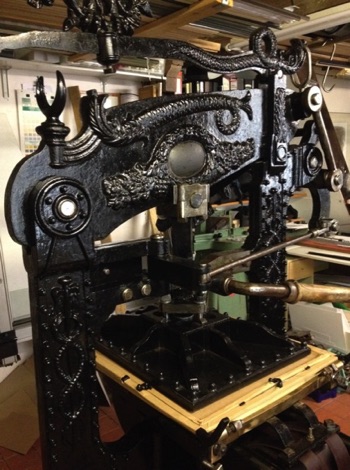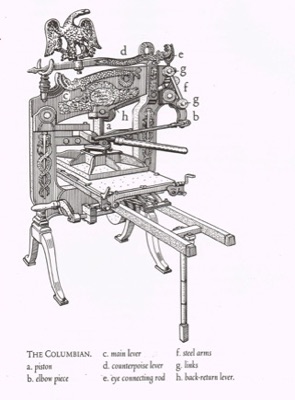
Welcome to the Bracken Press PRINT-workshop website
Intaglio (etching, drypoint, aquatint)
& block printing & wood engraving
(lino-prints, surface printing) & letterpress
Established 1974.

Occassionally we hear of printing equipment that is for sale, any item for sale will appear here.
Equipment for sale:-
Columbian Press
For Sale
Dixon & Co
1840 -1850 ( approximately)
No name plate.
Tympan & Frisket
Platen
18.25 x 24.25 ( inches)
465 x 615 mm
Bed
20.5 x 28 (Inches)
525 x 710 mm
80 (inches) Height
50 (inches) Wide
64 (inches) Long
£7500.00
Buyer to arrange removal
The Iron Printing Press
There are several types of printing press available to the iron press printer . Originally the preferred and available press being the old wooden press of Caxton which eventually led to the invention of the Columbian Press of 1813 by George Clymer.
Other Iron presses being Stanhope press, the Britannia, the Albion, the Cogger & the Imperial press. During the Victorian era smaller and more portable presses were made known as 'table tops' these presses became the favourite of small hobby printers.
The principle of the Iron press is this:-
The forme of type is placed on a flat plane of hard material. Over this is another flat plane of iron, the latter moves only vertically, always being kept parallel to the other. The sheet of paper to be printed, being upon the type, the moving plane approaches and finally comes in contact with it, the downward pressure of the top plane of iron causes the impression on the paper.
The setting up of an Iron press is most important, insomuch as the two pieces of iron should and always remain parallel to each other.
The flat plane, upon which the type is laid, is called the bed of the press. The flat plane which moves vertically is called the platen. These are the most important parts of the Iron press.
The bed of the press ideally needs to be moveable, so that the printed page can be removed and another clean sheet of paper can be loaded. This meant that the 'bed' be mounted on a set of rails. To move the bed a mechanism was installed called a rounce which would, upon being turned move the bed underneath the platen. To regiter the paper to the text another metal frame was attached to the edge of the bed, this being called the tympan. By affixing the paper to the tympan ( by means of registration marks and holders) each uniform piece of paper is exactly registered to the type.
